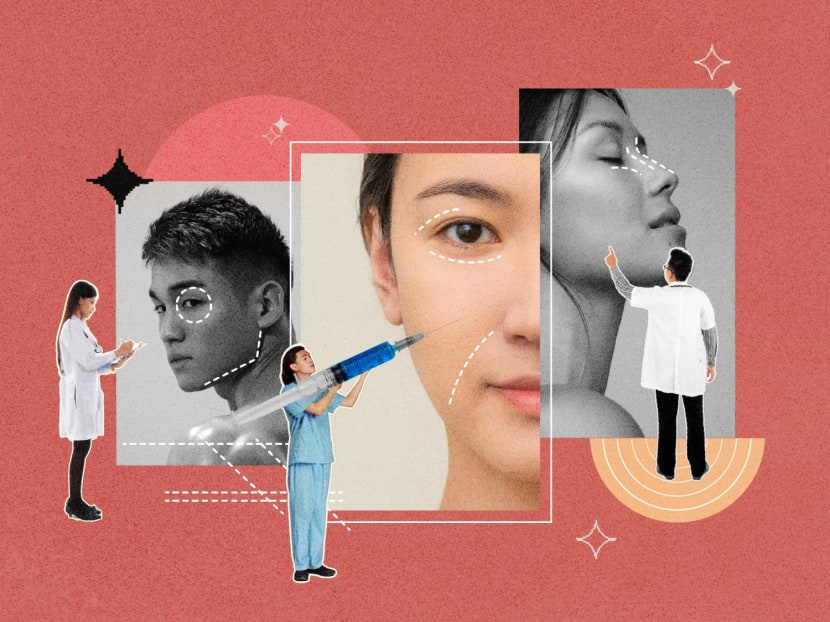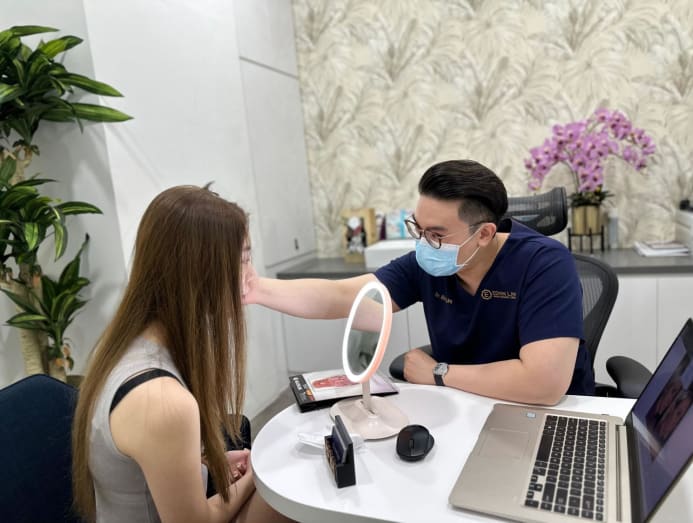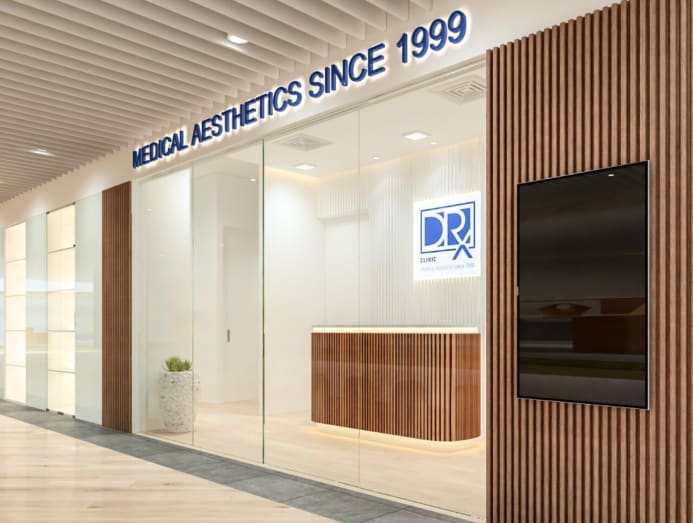Youths and seniors alike driving boom in aesthetics industry with treatments such as fillers, microneedling seen as self-care

SINGAPORE — When Mr Melvin Tay first started going for aesthetic procedures that involved skin tightening more than a decade ago in his late 20s, he was hesitant to talk to anyone about it.
“I had friends who would mock me and say, ‘Oh, you go for plastic surgery’,” the 44-year-old recalled. Back then, he would go for procedures such as Ulthera, which is a non-invasive skin lifting and tightening treatment.
Today, Mr Tay, who works in retail and education in the luxury sector, is willing to be more open about these treatments, having seen “good results” from them over the years.
He also noted that there is much less stigma now, with such aesthetic procedures becoming common.
“Now, (people see such treatments as) 'maintenance',” he quipped.
Mr Tay goes for aesthetic treatments once or twice a year now and he is aware that many others do the same.
Official numbers attest to this. The Ministry of Health (MOH) said that the number of licensed providers offering aesthetics services increased at an average of about 40 a year between 2020 and 2023.
By the end of last year, there were about 720 licensed providers in Singapore providing aesthetic services, making up about 14.5 per cent of all licensed healthcare, medical and dental service providers in Singapore.
Three aesthetic clinics and five doctors interviewed by TODAY said that the booming demand for aesthetic treatments in recent years has not been driven by a single group.
They have seen an increase in clients across age groups and genders.
Ms Eunice Chua, the general manager of aesthetics chain DRx, said that in the past, the chain's main clientele used to be women in their 30s to 50s. Today, it has seen a “significant increase” in younger clients who are 20 to 30 years old.
Similarly, Dr Edwin Lim, founder of Edwin Lim Medical Aesthetic Clinic, said his clinic has seen more clients across all ages, from adults in their 20s to those in their 60s who want to age gracefully and confidently.
Dr Chua Cheng Yu, who founded Veritas Medical Aesthetics in 2017, said that the younger clients take a “more proactive approach” in trying to prevent or delay the onset of signs of ageing.
The industry’s growth has been especially rapid in the past few years: Aesthetics chain DRx has been in the industry since 1999, but it was not until 2022 that it began opening more clinics and now has five outlets across the island.
Likewise, Edwin Lim Medical Aesthetic Clinic, which was established in 2018, opened the doors to its second clinic just two years later due to buoyant demand.
The doctors attributed the sector's rapid growth in the past few years to several factors: There is much less stigma around aesthetic procedures because online content normalising such treatments have proliferated on social media.
That being said, it does not mean that there is no stigma. People may be more willing to share openly among their circle of friends or online groups, but they may still be hesitant to reveal themselves publicly to people they do not know, such as some of the people who spoke to TODAY.
The doctors said another factor is that technological advances have birthed innovative treatments at more affordable prices.
They added that the Covid-19 pandemic also contributed to the boom in the aesthetics industry domestically, because the shutdown of international travel led people who had regularly sought treatments overseas to look for options at home.

THE NORMALISATION OF AESTHETICS
The rising number of aesthetic clinics here has created stiffer competition, which in turn has lowered prices and attracted a wider clientele, the doctors and clients said.
Long-time treatment-seekers Chua Huiling and David (not his real name), both 50, started going for aesthetic procedures more than a decade ago. These included lasers to deal with acne scars and hyperpigmentation, as well as fillers.
Dermal fillers, or soft tissue fillers, are injected beneath the skin’s surface to add volume and fullness. For example, fillers could help create a smoother, wrinkle-free appearance, or add more volume and fullness to one’s lips.
Commenting on the aesthetics landscape in Singapore today, Ms Chua, a sales manager, and Mr David, a freelance writer, said that the number of clinics has “definitely increased” over the years — perhaps, even to the point where there is now an overload of choices for customers.
Mr David said: “Whether that makes it easier to find treatment is debatable, since there are now so many places and lasers to choose from, and every clinic is selling all kinds of packages — and packages within packages — that make it difficult to make one-on-one price comparisons.”
For some newer clients such as 28-year-old Daniel who declined to reveal his full name, these packages are a win.
The engineer said that his interest was piqued when he came across social media content featuring “open conversations” about aesthetic procedures by customers who had undergone the treatments and were sharing reviews of their results, as well as videos made by doctors talking about the procedures they offered.
Last year, for his acne scars, he chose for the first time to go for microneedling, which involves making tiny pricks in the skin to stimulate a healing response.
“Acne scars were one of the contributors of my declining self-confidence and mental health, and out of curiosity, I went to a dermatologist for a simple consultation to see what I can do, and they offered me a package to try out.
“As technology improves, the results are getting better while being less invasive, so people are more willing to try and (they) usually do see results.”
Similarly, 33-year-old Sharon Yong, a customer experience professional, said that she was hesitant about aesthetic procedures even a few years ago due to the relatively high costs. It was also much harder to access others’ reviews or word-of-mouth feedback.
With more aesthetic clinics these days though, there are now “more choices, more reviews and (more) information to make informed decisions”, she added.
So early this year, she went for her first aesthetic procedures, which are a nose thread lift and botox injections. After that, she underwent surgery to get double eyelids and skin booster injections, among other minor treatments.
A 32-year-old public relations professional, who wanted to be known only as Amelia, said that she believes aesthetic procedures, even permanent ones, are common these days.
“There’s definitely more awareness now around the treatments available because of the advertisements you see on Instagram, in part due to the boom of influencer marketing.”
She first started getting aesthetic treatments such as baby botox — small doses of botox — when she was 23 years old. She has also gotten chemical peels, platelet-rich plasma injections and a lip filler.
“I think if done with a respectable clinic, it’s very safe, and when (the medical personnel) understand (why you want to do them), you feel more at ease and confident.
“Additionally, with such non-invasive treatments like fillers and botox, the downtime (for recovery) is low and the effect is not permanent, which is a good way to try something and not feel like you’re forever stuck with your decisions.”
Dr Chua of Veritas Medical Aesthetics said that since the pandemic, he has gotten more clients after more people started working from home.
“While it was hard to have treatments done regularly pre-pandemic, people are now able to arrange for treatments on their work-from-home days and deal with longer treatment downtimes due their more flexible schedules.”
Ironically, he added, the shift to the digital space during Covid-19 also heightened people’s desire to take better care of their appearances.
“When you get on Zoom video calls, you stare at your face up-close for hours on end while comparing yourself with others side by side, in real time.”

IS THE AESTHETICS BOOM SUSTAINABLE?
Aesthetics doctors are certainly profiting from this boom, but the growth has prompted concerns from some factions.
For starters, the rising demand has prompted more unauthorised home-based “aestheticians” looking to make a quick buck by providing unlicensed aesthetics services.
Another burgeoning issue is that the industry has drawn many qualified medical professionals away from other areas of practice.
In a June 27 commentary for TODAY, gastroenterologist Desmond Wai noted that rising burnout in the public healthcare system has driven quite a number of young doctors to pursue more lucrative roles in the private sector, such as in aesthetics.
He warned, though, that the high remuneration figures of aesthetics doctors — which could include an attractive starting pay of up to three times what young doctors last drew — may not last forever, because the sector could eventually reach a point of oversaturation.
Most in the sector who spoke to TODAY believe that the boom is here to stay, even if the sector may not enjoy the same rate of growth that it has seen in the past decade.
They also said that the growing number of aesthetics clinics could further drive down prices of treatments and procedures, making them more accessible and affordable and thus drawing even more new clients and prospects.
A junior aesthetics doctor, who declined to be named, said: “Personally, I don’t think the demand will fall anytime soon. Every day, there is someone turning 30, every day, there is someone who looks in the mirror and feels like something needs to be done.”
Still, some doctors believe that the sector’s growth could be limited by Singapore’s population size, strict regulations and the overall economic climate.
Dr Chiam Chiak Teng, who left the public healthcare system for a career in aesthetics medicine in early 2013, said that because the field of aesthetics is driven by the disposable income of its clients, the industry would naturally “thrive less” when the economy is poor.
“During good times, more clinics will sprout up hoping to have a piece of the pie.
"During bad times, less established or less well-run clinics will close down under the weight of high running costs, and the pool of clients consolidate to the bigger, surviving clinics.”
Still, he added: “I believe there will always be a demand for aesthetics services. As society becomes more affluent, people will always look for ways to improve their quality of life, and looking good is a big pillar of that.”
Dr Justin Sii, who has about a decade of aesthetics expertise under his belt, said: “I wish I could see the future, but look at what happened in a short span of the last three to four years that we did not see coming: Covid-19, wars, artificial intelligence… Like it or not, every industry including the medical industry gets affected one way or another by events like these.
“For now, I know I am making positive changes to my patients’ lives, one at a time, and that’s good enough for me.”








